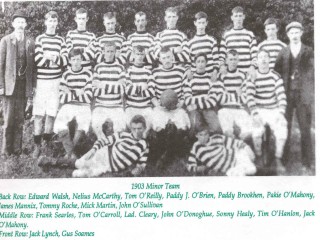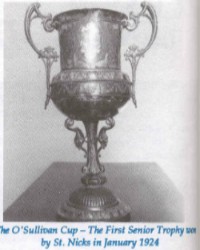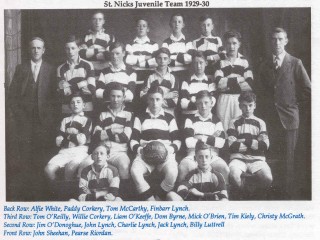
Contents
From the Beginning 1901-1917....charts the beginnings of the club and the people behind it.
All Hell Breaks Loose 1918...after many early successes the club is thrown into turmoil.
Back in Business 1922-1934...joining forces with Glen Rovers the club is poised for future success.
Continued...
St. Nicholas Football Club was formed in the year 1901, and was names after the old Catholic Church of St. Nicholas, which stood on the site of the present Church of the Annunciation. The club's first meeting-rooms were at No.3 York Row, Blackpool and these premesis were occupied until 1912. The first documented evidence of St. Nicks appeared in the Cork Examiner of September 5th 1901. It was an open letter to the Cork County Board of the G.A.A. asking them to consider a field in Kilbarry for the purpose of playing football games during the great Cork Exhibition of 1902. The letter read as follows:
"Sportsfield for Cork"
"Club Rooms,3 York Row, Blackpool. Dear Sir, - kindly allow the space in your valuable journal to draw the attention of the Cork County Board and other authorities interested, to a very suitable field which could be utilized for this purpose. It is situated at Kilbarry (only two minutes away from the Blackpool Tram Terminus). The old station house at Kilbarry (GS and WR) is quite convenient to the field and special trains could be easily be got to stop at same. It has an area of about fifteen acres, and possess all that could be desired in the way of being most suitable to a sportsman's wishes, having a fine level and smooth surface, and being large enough for any kind of tournament. Critics may say it is very far from town, but, comparing with other centers with its facilities, its a lot nearer, remembering that a filed of such size cannot be obtained nearer the city, and it would be a great mistake to get a small field, out of the way, at the present time, considering that we are having an exhibition here next year. As so many fields have have been offered, I would suggest that a suitable committee be formed (say representatives of Gaelic Football and Rugby teams) to examine and report on the most suitable one of the lot. Thanking you in anticipation.
Yours truly, Patrick Looney,
St. Nicholas Gaelic Football Club."
The first record of a St. Nicks game appeared on the "Cork Examiner" of November 25th 1901. The club members were continuously working to put the club on a firm footing and, on January 21st 1902, in a "Cork Examiner" report of a County Board meeting the following appeared:-

"Mr. Patrick Looney, Hon. Sec. St. Nicholas Football Club, Blackpool, wrote intimating the club had taken a field for twelve months, which was well suited for hurling and football matches. The field is situated at Dublin Hill, the entrance being from the Spring Lane side. The Club is also getting the filed paled-in during the Summer and has invited another club, Millfield, to join with them. The Club would commence on Sunday, January 26th and would feel obliged if the County Board would see its way to have some matches fixed, and the Club would give all the assistance possible. The President said the offer was a very kind one, for which the Board were very grateful..."
The first recorded victory of a St. Nicks Football Team was on March 9th 1902 when they defeated Dwyers by 0-9 to 1-4. The team that lined out on that historic day was:-
R.McMahon (Capt), D.Fleming(Vice-Capt), J.O'Sullivan, F.Searles, F.Douglas, W.Walsh, P.Dorgan,P.Murphy, B.Godfry, J.Nagle, S.Coakley, R.O'Neill, V.Sullivan, J.Healy, E.Higgins, J.Sheehan and E.McGuckin.
The Cork County Board set up an Independant Minor Board in 1904 and they organized a Minor Championship for 1905 which was open to players of all ages provided they had not played First or Seconds Championship. The club entered this Championship in 1905 adn 1906 without success but, in 1907, the first county title was won when the team defeated Redmonds in the County Minor Final. This was greeted with great jubilation in Blackpool. The title was retained in 1908 and the team went on to record an unbelievable three in a row by beating Mallow in the final of 1909. The competition could be compared to the present Cork County Junior Championship. The club, now in triumphant mood, moved up a grade and took part in the Intermediate Championship of 1910, only to be defeated by Kanturck who subsequently won the competition. The following year was also unsuccessful but was a very historic year for football in the county as the senior footballers won the All-Ireland Championship, beating Antrim in the Final. The junior footballers won the Munster Junior Championship, defeating Waterford in the final and as the All-Ireland Junior Championship did not commence until 1912 they had to be satisfied with provincial honours. However, the victory was significant for, included in the team, was the first player from St.Nicks to win inter-county honours with Cork. His name was Tony O'Reilly who was to become a major influence in the progress of the club for the next fifty-five years. He was a towering figure for his club and county especially on the administrative side of affairs, for over half a century. During this period a split was caused in the club due to political difference and several players and members left to form O'Briens Football Club. The differences were resolved in 1912 and the club moved to new rooms at Wherland's Lane.

In 1916 a meeting of major significance took place at the Glen Boxing Club in Spring Lane. This meeting was called to form a hurling club in the area and it was agreed that this should be done, and the club named Glen Rovers. This decision meant the birth of one of the Association's most illustrious clubs which, in time, would prove to be of immense benefit and assistance to St. Nicks and also to hurling in Cork.St.Nicks continued to function but it was 1917 before further successes came. The club's first team played in Division Two of the County Championship and displayed dramatic improvement in skill. Having defeated Macroom and Nils, they qualified to meet Fermoy in the County Final in Mallow. In a blinding snowstorm the team overwhelmed Fermoy by seven goals and seven points to nil.
Expectations were very high for 1918. Whenthe county championship draw was announced the club was paired against Nils, the reigning county champions. St. Nicks were regarded as easy prey but, as many others learned, to their cost, in later years, reputations counted for vey little in Blackpool when the crunch came. Nils were torn apart by an eager and competitive young team, St. Nicks were victorious on the score of 3-3 to 3-2 and went on to meet Fermoy in the next round. The game was fixed for Midleton but was abandoned by the referee due to fighting.
The Cork Examiner reported:-
"St. Nicholas v Fermoy, Cork County Championship, Disgraceful Scenes, Match Abandoned.
'It was to be regretted that scenes of a disgraceful character should, again, have been associated with the meeting of St. Nicholas and Fermoy in the Senior County Championship at the Cork Athletic Grounds yesterday afternoon. Originally fixed for the Midleton venue, the match was not concluded owing to a disturbance that took place, but it was hoped that the second meeting of the teams would produce a thrilling and scientific game, in which there would be an absence of any disorderly conduct. This hope, however, was not realized. With the exception of one or two showers, fine weather was in evidence, and there was a large attendance, but betting on the result of the contest was freely and openly conducted - it is believed that large sums of money were at stake - and to this fact may be attributed a great deal of the disorder that was witnessed. During the opening period the game was played in a fairly good spirit and some very brilliant passages of play were witnessed on the part of each team. At the interval St. Nicholas, who were favored by a fairly strong wind, had established a lead of two points. Early in the second half Fermoy secured a minor score, and only a point then separated the two teams. Fermoy continued to attack and play then became very vigorous and exciting. During one of these attacks a Fermoy forward was fouled, in a most deliberate fashion by one of the St. Nicholas players, and injured. The Fermoy player was running after the leather, but before he could reach it the St. Nicholas player jumped onto his chest or abdomen, at the same time applying his two clenched fists to the players face, with the result that the Fermoy player was dashed to the ground injured. It was a most uncalled for action on the part of the St. Nicholas player.The referee immediately ordered thsi player to leave the filed, and the player was proceeding to retire when some other members requested him not to do so. While the injured Fermoy player was being attended to - he recovered after some time - a consultation took place among the members of the St. Nicholas team as to whether the player ordered off the filed should obey the referees ruling. After suspension of play for a quarter of an hour the player in question retired, to the accompaniment of cheering from the members and supporters of his team, and the game was continued. Players on each side, however were quickly in handgrips, and fights. The referee again stopper play, and administered severe warning to the offenders, and it seemed that there would be no repetition of such despicable scenes. However play had again been in progress a very brief time when some of the St. Nciholas players indulged themselves in most aggressive tactics towards their opponents. Fermoy players, who were playing a decent game, were tripped, beaten and kicked without the slightest provocation having been given, and no doubt very serious results would have followed only for the prompt action taken by the referee. It was evident that such cowardly and disgraceful, as well as unwarranted assaults, could not be permitted, and the referee stopped the game and declared the match abandoned. It was a proper and wise course to adopt.' The score at this time was St.Nicholas 1-1 Fermoy 0-3. Referee: Mr. T. Irwin"
The following letter appeared in the paper two days later:-
"Dear Sir, With reference to your report of the Fermoy vs St. Nicholas match on Monday's issue I wish to state that the facts are, that the Fermoy player was in possession of the ball when the St. Nicholas player, endeavoring to obtain it, alighted on his opponents chest, putting him out of play for three or four minutes, after which he was able to resume. Neither did the St. Nicks player apply his two clenched fists to the Fermoy player's face. It is incorrect to state that the free fights ensued and that blows were freely exchanged in different positions of the St. Nicholas territory. I may also add that only four frees were given against our team, while nine were given against Fermoy for breach of the rules. In view of the latter fact, I am at a loss to see how it could be stated Fermoy were playing a decent game and without slightest provocation were 'tripped, beaten and kicked', and this opinion is shared by prominent members of the association.
Faithfully Yours, T.J.O'Reilly, 53 Thomas Davis Street, 18th June, 1918"
An investigation ws held by the County Board and, while this was in progress, the St. Nicks delegation became embroiled in an unmerciful row inside, and outside, the boardroom. Everyone agreed that serious mayhem had taken place on both days and that the repercussions would be grave. The tragic result of all this was that the "whole club" was expelled from the association forever. When the Chairman of the County Board was asked what was meant by the "whole club" he replied "The present St.Nicks, the past St.Nicks and all St.Nicks to come". While it is fair to say that much of the commotion that occurred was due to actions on the field, it is believed that the political upheavals in the country at the time may have been the underlying cause of much of the furore. Many efforts were made to have the club readmitted but they failed. However football continued in Blackpool as Glen Rovers entered the Minor Championship of 1919. They qualified for the County Final against Cobh, but the game was not finished as the only ball available "burst" with Cobh leading by 1-0 to 0-1. It is believed that the ball may have not have "burst" of its accord and the game was never replayed.
Following the truce between the Irish and British forces, the County Convention of 1922 granted an amnesty to all suspended players and clubs. St. Nicks were back in the fold but the GAA was in turmoil due to the "troubles" and competitions were not finished for many years. A special football league was organized at the end of 1923 and the final between UCC and St. Nicks took place in January 1924. St. Nicks were victorious on a scoreline of 4-2 to 1-1.

In 1925 and 1926 the senior team were defeated by Nils and Macroom in the County Championship. Both of these clubs won the title, and this was some consolation. It is of interest to note that Tom O'Reilly refereed the 1926 County Final.
The twenties proved to be very disappointing for the club and in 1929 it was decided to regrade to Intermediate. There was a widely held view that the club was in trouble, but this was by no means, correct. Guided by Tom O'Reilly and Christy McGrath the club was very successful in the North Parish competitions, the Minor and Junior city and county championships. This policy of concentrating on youth paid great dividends. The North Monastery C.B.S. proved to be a great nursery and standards improved dramatically. All the heartbreaks, defeats and suspensions were forgotten when the Intermediate County Championship of 1937 was won.
During the early thirties, the club left its premises at Wherlands Lane and joined forces with Glen Rovers in Bird's Quay. This was a natural development, since both clubs were now made up of much the same personnel, and prominent officials of Glen Rovers, such as Willie Connors and Paddy O'Connell were also very much involved with St. Nicks. The first major breakthrough came in 1934 when Glen Rovers won the Senior County Championship for the first time, and St. Nicks were defeated in the final of the Intermediate Football Championship. Together both clubs were to be a major force in hurling and football from that very eventful year.
Continued........
